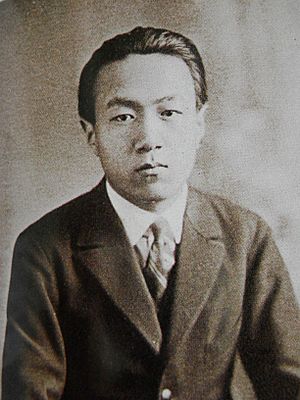Shōhei Ōoka facts for kids
Quick facts for kids
Shōhei Ōoka
|
|
|---|---|

Shōhei Ōoka
|
|
| Native name |
大岡 昇平
|
| Born | March 6, 1909 Tokyo, Japan |
| Died | December 25, 1988 (aged 79) Tokyo, Japan |
| Resting place | Tama Cemetery, Fuchū, Tokyo, Japan |
| Occupation | writer |
| Alma mater | Kyoto Imperial University |
| Genre | novels, literary criticism, short stories, non-fiction |
| Notable works | Fires on the Plain (1951) |
| Notable awards | Yomiuri Prize (1961), (1989) Shinchosha Literary Prize (1961) Mainichi Art Prize (1971) Noma Literary Prize (1974) Asahi Prize (1976) Mystery Writers of Japan Award (1978) |
Shōhei Ōoka (大岡 昇平, Ōoka Shōhei, 6 March 1909 – 25 December 1988) was a famous Japanese writer. He wrote novels, worked as a literary critic, and taught about and translated French literature. He was active during Japan's Shōwa period. Ōoka was one of the writers who often wrote about their experiences during World War II, both at home and while serving abroad. He wrote many short stories and essays for almost every literary magazine in Japan.
Early Life and War Experience
Ōoka was born in Tokyo, Japan, on March 6, 1909. His parents were from Wakayama prefecture. His father was a stockbroker, and his mother was a geisha. From a young age, Ōoka was encouraged to study literature. He became very good at French while in high school.
His parents even hired a famous literary critic, Kobayashi Hideo, to be his tutor. Through Kobayashi, Ōoka met other people who would become well-known writers, like the poet Nakahara Chūya. In 1929, he started studying literature at Kyoto Imperial University and graduated in 1932.
After college, he worked as a journalist for a newspaper for one year. But he soon left to focus on studying and translating books by French writers like Stendhal. To earn money, he worked as a translator for a French-Japanese company in Kobe.
In 1944, when he was 35, he was drafted into the Imperial Japanese Army. After only three months of basic training, he was sent to the front lines on Mindoro Island in the Philippines. He worked as a communications technician. His group was attacked, and many soldiers died. In January 1945, American forces captured him, and he became a prisoner of war on Leyte Island.
Surviving the war was very difficult for Ōoka. He felt troubled that he, an older soldier, had lived when so many others had not. He returned to Japan at the end of 1945.
Becoming a Writer
Ōoka began his writing career after he returned home from the war. His former French tutor, Kobayashi Hideo, encouraged him. Ōoka published a short story about his experiences as a prisoner of war. It was called Furyoki (meaning "Taken Captive: A Japanese POW's Story"). It was published in parts between 1948 and 1951.
This story was very popular and won the Yokomitsu Riichi Prize in 1949. This success encouraged him to become a full-time writer.
Famous Novels
- His next book was Musashino Fujin ("A Wife in Musashino", 1950). This was a psychological novel, meaning it explored the thoughts and feelings of its characters. It was inspired by the works of Stendhal.
- Ōoka's most famous novel is Nobi ("Fires on the Plain", 1951). This book was also highly praised and won the important Yomiuri Prize in 1951. It is considered one of the most important novels written after World War II. The story is based on his own war experiences in the Philippines. Nobi explores what it means to be human when people are struggling to survive, even facing extreme hunger. A film was made based on the book in 1959.
- In 1958, he wrote Kaei ("The Shade of Blossoms"). This novel was different from his war stories. It was about an older nightclub hostess trying to survive in the busy Ginza district of Tokyo in the 1950s. Even though the setting changed, his characters still faced tough challenges in difficult environments. Kaei won the Shinchosha Literary Prize in 1961.
- From 1953 to 1954, Ōoka was a visiting professor at Yale University in the United States. He also taught French literature at Meiji University in Tokyo.
- In the late 1960s, he returned to the topic of the Pacific War. He wrote a detailed historical novel called Reite senki ("A Record of the Battle of Leyte", 1971). He spent three years researching and gathering information for this book. Like all his writings, it looked at war from the point of view of someone who was forced to fight even if they had doubts. This novel won the Mainichi Art Award.
In 1971, he was asked to join the Japan Art Academy, a prestigious group of artists and writers. However, he chose not to join, partly because of his experiences as a soldier and prisoner of war.
Besides novels and translations, he also wrote biographies about other writers, which won the Noma Literary Prize in 1974. He received the respected Asahi Prize in 1976 and the Mystery Writers of Japan Award in 1978.
Shōhei Ōoka passed away in 1988 at the age of 79. He is buried at the Tama Cemetery near Tokyo. After his death, he was given a second Yomiuri Prize in 1989 for a biography he wrote about another famous Japanese writer, Natsume Sōseki.
In 1994, when the Japanese writer Kenzaburō Ōe won the Nobel Prize in literature, he mentioned Shōhei Ōoka as one of the Japanese writers who helped pave the way for him to win the prize.
See also
 In Spanish: Shōhei Ōka para niños
In Spanish: Shōhei Ōka para niños
- Japanese literature
- List of Japanese authors
- The Second Generation of Postwar Writers

